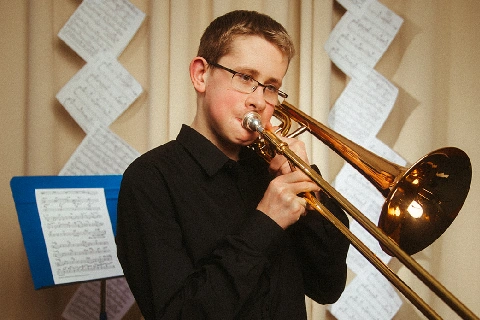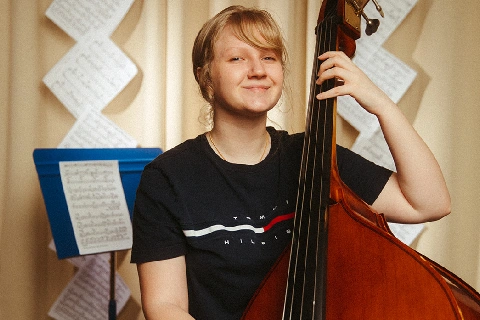The following are guidelines to help you have a successful, rewarding, experience in learning the guitar or bass. We have arrived at these conclusions after many years of teaching hundreds of students.
1. Starting at the Right Age
Of course adults can start an instrument at any time. The real determination of success is the ability and willingness to commit to practicing. The key is the desire and not being too hard on yourself.
For children, starting at the right age is key to the success of their lessons. The sooner the better isn’t always right for an optimal learning experience. Waiting until the child has reached the right age and mental and physical level greatly improves the odds of success.
For guitar lessons we recommend waiting until 7 years of age. For bass guitar we suggest waiting until at least 10. In some cases where the desire is great, we will do a short evaluation of a younger student to see if they are physically and mentally ready to start. If they cannot get a clear tone when they press on the string due to lack of hand strength, then we would suggest waiting.
Starting on piano or violin would be a better choice for such a student. Physically these instruments are easier than the guitar or the bass. Therefore a student can learn about notes and timing on one of these easier instruments and then when he or she wants to switch to guitar or bass later, he/she will have a strong basic musical foundation to work from.
2. Small Beginners Should Use a Small Guitar
There are child-size acoustic, electric, and bass guitars. An electric guitar is easier to handle (less bulky) than an acoustic, and the tension on the strings is also lighter than on an acoustic. Therefore, contrary to popular belief, we encourage starting on an electric when the child is leaning that direction. The skills developed on one type of guitar will directly translate to another. So if you are small, get a small instrument. We even rent small instruments. If you think you should go small but don’t want to purchase, go ahead and rent for a while until the student grows another inch or two.
3. Performing Builds Confidence
You don’t have to be a great musician to perform. A student that has a few months of dedicated practice should be able to play at least one song from start to finish. It doesn’t have to be a difficult piece. The experience of performing builds the student’s confidence and creates the desire to tackle even more challenging material. A well-rounded musical program will include performance opportunities in the way of showcases, recitals, outdoor concerts, and other occasional events throughout the year. At a school like ours, where all of the instruments are taught, the student is able to choose between performing solo or with a full band.
4. For the Best Results, Choose Private Instruction
Group lessons work well for beginners to get exposure to an instrument, and to let parents know the desire level and practice habits of the child. Playing in a group, rock, jazz, etc. also must be rehearsed in a group setting.
However, when actually learning how to play an instrument, private lessons are undeniably superior since the student has the undivided attention of the instructor. Also, the student can progress at his or her own pace, with extra time being spent on the individual student’s desires and weaknesses. The pressure of having to keep up with other students or the frustration of having to wait for other students who may not have even practiced their lesson can be very discouraging. With private lessons, progress is expedited and the student gets a customized lesson providing him with the knowledge he wants and needs.
5. Be Aware of the Quality of the Teacher
Of course there are many very good musicians that never studied their instrument formally. Some have learned by ear or picked up knowledge from friends along the way. But to be able to properly teach someone else, there should be a certain level of formal education that has been achieved. This way the student knows that the instructor has taken the time to train in the field that he is teaching. Not only do most of our instructors have university, college, or music conservatory degrees on their instrument, but all of our guitar and bass instructors also perform regularly on stages ranging from local to national.
When teaching children, knowing how to relate at their level and keep them motivated is just as important as being knowledgeable on the instrument. A good school will choose from a pool of many potential instructors, saving you the time and trouble of searching for a well qualified, professional teacher. In our music academy, the lessons are not just a hobby or sideline for the teacher but a career and responsibility, which are taken very seriously.
6. Learning in an Appropriate Setting
Not only is it necessary to have a qualified teacher, but also having an optimal learning environment is very important. With ½ to 1 full hour of lesson time per week, a professional school environment can produce better results since all of the time is focused on learning music and all of the tools and materials necessary are already in place. Although a traveling teacher sounds like a good idea for convenience sake, the reality is that there are distractions like phones, pets, or other kids which sometimes make concentrating difficult. It is also common during a lesson to have a situation come up where a specific problem needs to be addressed. With a complete library of musical materials and references readily available a teacher teaching at an academy can address the problem immediately rather than putting it off until the next week. Hearing peers who are at different levels of progress can also inspire students.
7. Purchase a Chromatic Tuner ASAP
Unfortunately, a guitar or bass must be tuned by the player daily and often several times a day if it’s being played for long durations. If the instrument is not tuned, it will usually be somewhere between slightly out of tune and extremely out of tune. The reasons for going out of tune are numerous. Common reasons would be:
- Brand new strings (still stretching)
- Tuners (mechanism used for tuning) getting bumped or moved by accident, or are low quality and don’t hold string well.
- Change in temperature
- Change in humidity
- Oldstrings
It really doesn’t matter what the reason is, what does matter is that the player be able to get the guitar in tune. There are few things less motivating than playing an out of tune instrument. There are several ways of tuning a guitar. Here are a few possibilities:
- Tune to a pitch pipe or a tuning fork
- Tune to another guitar or piano (that has been tuned)
- Tune to a standard guitar tuner (6 string)
- Tune to a chromatic tuner (easiest)
Although all of these methods do work, by far easiest is by using a chromatic tuner. The difference between a “standard guitar tuner” and a “chromatic tuner” is simple. The standard tuner will only register (respond) when it hears 1 of the 6 notes that the guitar is normally tuned to. That may sound like it solves your problem, but does it really? What if your guitar is out of tune to the point of not even being close to one of these 6 notes? The standard tuner will not help because it can’t hear the note. The chromatic tuner will hear any note and display whatever note it is hearing back to you. Once you know what note you are actually on then you can decide whether you need to tune higher or lower to get to the note you are supposed to be on. Since the chromatic tuner ($25 – $30) is only about $10 more than a standard tuner it is definitely worth the investment, in our opinion. If you own a smart phone, you can find guitar tuner apps for free that work very well.
8. Purchase a Metronome (or Drum Machine)
A metronome is just a device that makes a clicking sound. You set the speed of the click to the recommended speed or if there is no recommended speed, you set the speed to a point that you are able to play your song or exercise that you are practicing. A drum machine is really just a deluxe metronome with cooler sounds that costs more money. It can be used for the same purpose. If you have an electronic keyboard that has programmed rhythms, that can work instead of a metronome too.
9. Making Practice Easier
As in all things, improvement in music takes practice. One of the main problems with studying an instrument is the drudgery of practicing and the fight between students and parents that ensues. How to make practice easier:
- Time – Set the same time each day to practice so that it becomes a routine or habit. This is especially good for children but works for adults too. The earlier in the day that this happens the more likely the practice will not be put off until tomorrow.
- Repetition – This method works quite well when setting practice schedules for beginners. For a younger person 20 or 30 minutes may seem like an eternity. Therefore instead of a time frame we suggest repetition. For example do this song 4 times each day and this scale 5 times a day. Then the clock is not the enemy, as soon as the work gets done (correctly) the child is free.
- Rewards – Children respond well to rewards. As parents we can reward the child by saying when your practice is complete you can have x number of minutes on the PlayStation or other coveted activity. As teachers we sometimes will use stickers or more importantly, the praise of the teacher “Excellent job, keep it up” can be the best reward. For adults, usually a nice cup of java or other beverage will make the experience a little more rewarding.
In conclusion, playing a musical instrument should be an enjoyable experience, not a stress inducer. There will be times, usually at the end of the term for children, or a big project at work for adults, when the student will not able to practice. The goal is to learn at your own pace, not at the pace your friend or idol learned. As long as you know that you want to learn the instrument and that you are giving it your attention as much as is realistically possible, then you are being successful. The fun is the journey.





